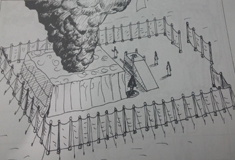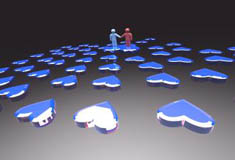Face-to-Face Communication: The Silent Exchange of Body Language
הרב שי טחןיג אדר א, תשפד22/02/2024The act of looking at someone's face is a powerful social cue that goes beyond mere visual contact...
תגיות:תרומהשפת גוףפנים
ופניהם איש אל אחיו (שמות כה,כ)
The act of looking at someone's face is a powerful social cue that goes beyond mere visual contact. It signifies openness, engagement, and a willingness to connect. In contrast, avoiding eye contact or turning away can convey a sense of unease, lack of trust, or even intentional avoidance.
intentional avoidance.
When you look someone in the face while engaging with them, it communicates a profound sense of love and respect. It signifies that you value their presence, acknowledge their humanity, and are genuinely interested in connecting with them on a personal level. By making eye contact and focusing on their expressions, you convey sincerity, empathy, and a willingness to listen and understand.
Conversely, avoiding eye contact or refusing to look at someone's face can convey a lack of regard or even disrespect. It may imply disinterest, discomfort, or a sense of superiority, sending a message that the person isn't worthy of your attention or consideration.
In many cultures and social contexts, looking someone in the face is seen as a fundamental aspect of communication and interpersonal connection. It fosters trust, strengthens bonds, and builds rapport between individuals. It's a nonverbal way of saying, "I see you, I hear you, and I value you as a fellow human being."
In essence, the act of looking someone in the face reflects a deep-seated recognition of their worth and an affirmation of their dignity. It's a powerful gesture that transcends words and speaks volumes about the love, respect, and empathy we feel toward others.
The Gemara in Yerushalmi (ערלה פ״א ה״ג) says: מאן דאכיל דלאו דיליה, בהית לאסתכולי באפיה, meaning that someone who receives food from others feels embarrassed to make eye contact with them.
Conversely, there are situations where looking at someone's face is encouraged, such as when learning from a teacher or receiving guidance.
The Gemara (הוריות יב,א) suggests the pasuk: ״והיו עיניך רואות את מוריך״ (ישעיה ל,כ) to highlight the positive impact of gazing at a teacher's face during studying torah, emphasizing the importance of visual connection in the learning process.
Another Gmara says (Eruvin 13b): אמר רבי האי דמחדדנא מחבראי דחזיתיה לר' מאיר מאחוריה
ואילו חזיתיה מקמיה הוה מחדדנא טפי
Rebbi mentioned in that the reason he excelled in sharpness compared to his peers in yeshiva was because he paid attention and looked at his rabbi.
In the context of the Parasha, the depiction of the Keruvim (golden figures resembling babies) in the Mishkan serves as a symbolic representation of the relationship between Hashem and the Jewish people. The orientation of the Keruvim—either facing toward each other or turned away—symbolizes the spiritual closeness or distance based on the fulfillment of Hashem's will and mitzvot. This visual imagery reinforces the notion that facial expressions and visual cues play a profound role in conveying emotions, connections, and spiritual alignment across various facets of life.
A challenge to the aforementioned concept is presented in a letter that the Ramban wrote to his son in Catalonia regarding the practice of humility. He instructed his son to read this letter once every week, to teach it to others, and to commit it to memory, aiming to instill in them a reverence for Heaven from a young age. The Ramban assured his son that the day he read this letter, his prayers would be answered from Heaven. Furthermore, those who regularly recited it would be spared from all suffering and guaranteed a share in the world to come.
In his writings, he emphasizes humility with the following words: "Therefore, I will now explain to you how to always behave humbly. Speak gently at all times, with your head bowed, your eyes looking down to the ground, and your heart focused on Hashem. Don't look at the face of the person to whom you are speaking. Consider everyone as greater than yourself. If they are wise or rich, show them respect. If they are poor and you are richer—or wiser—than them, consider yourself guiltier than them, and regard them as more worthy than yourself. For when they sin, it is likely through error, while your transgressions are deliberate, and you should know better!"
According to the Ramban's writings, the correct approach is to avoid looking directly at someone's face while speaking to them. However, it's crucial to understand the intention behind this guidance. The Ramban is instructing individuals on how to cultivate the traits of modesty and humility. If one indeed lowers their gaze for these noble reasons, it is praiseworthy. In such a case, the act of lowering one's eyes is expressive and visibly demonstrates their commitment to these virtues.
However, there's a distinction to be made between someone who consciously chooses to lower their gaze as an expression of humility and someone who avoids eye contact out of discomfort or intimidation. The former reflects a deliberate effort to embody humility, while the latter may indicate different underlying motivations or insecurities.
The act of looking at someone's face is a powerful social cue that goes beyond mere visual contact. It signifies openness, engagement, and a willingness to connect. In contrast, avoiding eye contact or turning away can convey a sense of unease, lack of trust, or even

When you look someone in the face while engaging with them, it communicates a profound sense of love and respect. It signifies that you value their presence, acknowledge their humanity, and are genuinely interested in connecting with them on a personal level. By making eye contact and focusing on their expressions, you convey sincerity, empathy, and a willingness to listen and understand.
Conversely, avoiding eye contact or refusing to look at someone's face can convey a lack of regard or even disrespect. It may imply disinterest, discomfort, or a sense of superiority, sending a message that the person isn't worthy of your attention or consideration.
In many cultures and social contexts, looking someone in the face is seen as a fundamental aspect of communication and interpersonal connection. It fosters trust, strengthens bonds, and builds rapport between individuals. It's a nonverbal way of saying, "I see you, I hear you, and I value you as a fellow human being."
In essence, the act of looking someone in the face reflects a deep-seated recognition of their worth and an affirmation of their dignity. It's a powerful gesture that transcends words and speaks volumes about the love, respect, and empathy we feel toward others.
The Gemara in Yerushalmi (ערלה פ״א ה״ג) says: מאן דאכיל דלאו דיליה, בהית לאסתכולי באפיה, meaning that someone who receives food from others feels embarrassed to make eye contact with them.
Conversely, there are situations where looking at someone's face is encouraged, such as when learning from a teacher or receiving guidance.
The Gemara (הוריות יב,א) suggests the pasuk: ״והיו עיניך רואות את מוריך״ (ישעיה ל,כ) to highlight the positive impact of gazing at a teacher's face during studying torah, emphasizing the importance of visual connection in the learning process.
Another Gmara says (Eruvin 13b): אמר רבי האי דמחדדנא מחבראי דחזיתיה לר' מאיר מאחוריה
ואילו חזיתיה מקמיה הוה מחדדנא טפי
Rebbi mentioned in that the reason he excelled in sharpness compared to his peers in yeshiva was because he paid attention and looked at his rabbi.
In the context of the Parasha, the depiction of the Keruvim (golden figures resembling babies) in the Mishkan serves as a symbolic representation of the relationship between Hashem and the Jewish people. The orientation of the Keruvim—either facing toward each other or turned away—symbolizes the spiritual closeness or distance based on the fulfillment of Hashem's will and mitzvot. This visual imagery reinforces the notion that facial expressions and visual cues play a profound role in conveying emotions, connections, and spiritual alignment across various facets of life.
A challenge to the aforementioned concept is presented in a letter that the Ramban wrote to his son in Catalonia regarding the practice of humility. He instructed his son to read this letter once every week, to teach it to others, and to commit it to memory, aiming to instill in them a reverence for Heaven from a young age. The Ramban assured his son that the day he read this letter, his prayers would be answered from Heaven. Furthermore, those who regularly recited it would be spared from all suffering and guaranteed a share in the world to come.
In his writings, he emphasizes humility with the following words: "Therefore, I will now explain to you how to always behave humbly. Speak gently at all times, with your head bowed, your eyes looking down to the ground, and your heart focused on Hashem. Don't look at the face of the person to whom you are speaking. Consider everyone as greater than yourself. If they are wise or rich, show them respect. If they are poor and you are richer—or wiser—than them, consider yourself guiltier than them, and regard them as more worthy than yourself. For when they sin, it is likely through error, while your transgressions are deliberate, and you should know better!"
According to the Ramban's writings, the correct approach is to avoid looking directly at someone's face while speaking to them. However, it's crucial to understand the intention behind this guidance. The Ramban is instructing individuals on how to cultivate the traits of modesty and humility. If one indeed lowers their gaze for these noble reasons, it is praiseworthy. In such a case, the act of lowering one's eyes is expressive and visibly demonstrates their commitment to these virtues.
However, there's a distinction to be made between someone who consciously chooses to lower their gaze as an expression of humility and someone who avoids eye contact out of discomfort or intimidation. The former reflects a deliberate effort to embody humility, while the latter may indicate different underlying motivations or insecurities.
הוסף תגובה
עוד מהרב שי טחן
עוד בנושא פרשת שבוע







